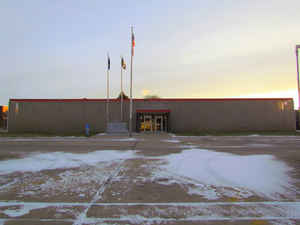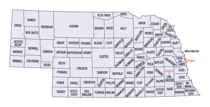Nebraska Counties
There is ninety-three counties in state of Nebraska. Despite the fact that Sarpy County contained the oldest settlement in the state, it was one of the last lands along the river to be recognized by law. Finally, on February 1, 1857, the land "where the cities meet the country" was officially created.Keith County, Nebraska
Keith County Education, Geography, and History
Keith County is a county located in the state of Nebraska. Based on the 2010 census, the population was 8,368. Its county seat is Ogallala.
Etymology - Origin of Keith County Name
Keith County was named in honor of M.C. Keith of North Platte, who owned one of the largest ranches at that time in Western Nebraska. He was also the grandfather of Keith Neville, governor of Nebraska from 1917 to 1919.
Demographics:
County QuickFacts: CensusBureau Quick Facts
Keith County History
Keith County is probably best known
today for being the home of Lake McConaughy and the Kingsley Dam. But in the
early days, the area that would become Keith County was best known for cattle
and cowboys.
The Oregon, Overland and Mormon Trails all played an important role in bringing
early travelers through the area. Prior to that the area was seen only by
trappers and the Pawnee and Sioux tribes. But with the trails and then the
westward advancement of the Union Pacific Railroad, the area along the North and
South Platte Rivers began to develop.
When organized on May 3, 1873, Keith County was named in honor of M.C. Keith of
North Platte, who owned one of the largest ranches at that time in Western
Nebraska. He was also the grandfather of Keith Neville, governor of Nebraska
from 1917 to 1919. Ogallala was named as the county seat.
When the railroad passed through the area in the 1860s, the famous
Texas-Ogallala Trail was forged to bring longhorn cattle to the shipping yards
in Ogallala. From there they were transported to Midwestern markets or to
Wyoming and Montana. With the cattle and cowboys came trouble. Ogallala's hotels
and saloons served as sites for western cattlemen and Texas cattle kings to
bargain over prices. History indicates that the gold flowed freely across the
tables, the liquor across the bars, and occasionally blood across the floors.
Ogallala became the site of the famous Boot Hill cemetery in 1875. For years it
served as a burial place for settlers, transients and others who took part in
the growth of Ogallala.
The Kingsley Dam on the North Platte River was constructed after the turn of the
century to provide irrigation water for farmers in the central part of the state
and hydro-electric power. For many years it was the world's second largest
earthen dam. The lake that resulted, affectionately known as "Big Mac," is 25
miles long, has a shore line of about 100 miles, and provides a variety of
recreational activities for tens of thousands of people each year.
Geography: Land and Water
As reported by the Census Bureau, the county has a total area of 1,110 square miles (2,900 km2), of which 1,062 square miles (2,750 km2)
is land and 48 square miles (120 km2) (4.3%) is water.
Neighboring Counties
Bordering counties are as follows:
- Arthur County - north
- McPherson County - northeast
- Lincoln County - east
- Perkins County - south
- Deuel County - west
- Garden County - northwest
Education







